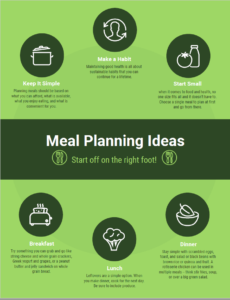With all the beautiful food photos and recipes that you encounter on Pinterest, Instagram, and Facebook, it’s easy to become overwhelmed. Plus, the plethora of diet and health information available is a blessing and a curse. How do you eat clean? Should you follow the keto diet or try intermittent fasting? It’s enough for most of us to throw our hands up in defeat and head straight to the phone to order a pizza.
The good news is that when it comes to food and health, no one size fits all and it doesn’t have to. If you’re not a gourmet cook, never fear! The majority of folks have not been trained in the best culinary kitchens of America.
Planning meals should be simple. Ideally, it should be based on what you can afford, what is available, what you enjoy eating, and what is convenient for you. Maintaining good health is all about sustainable habits that you can continue for a lifetime. So where do you start?
Begin by picking one meal that you’d like to work on. Say, breakfast. Breakfast can range from an apple and peanut butter and whole grain toast to zucchini muffins and fruit. It doesn’t need to be eggs Benedict.
While there are many reasons to skip breakfast, if you’re out of time, try something you can grab and go like string cheese and whole grain crackers, Greek yogurt and grapes, or a peanut butter and jelly sandwich on whole grain bread. While toaster pastries or frozen breakfast sandwiches are convenient, these are highly processed, high in calories, sugar, fat, and sodium, and won’t provide the nutrients your body really needs to get you going.
To maintain good energy throughout your morning, choose things that contain protein (eggs, Greek yogurt, cottage cheese, string cheese, or peanut butter) and something high in fiber (whole grain breads and cereals, whole grain crackers, steel cut oats, etc). These nutrients help regulate your appetite and blood sugar, which results in sustained energy.
At lunch, leftovers are a simple option. When you make dinner, cook extra rice, protein (chicken/fish), and vegetables to be packed up the next day. Be sure to include produce. Frozen vegetables are great for variety or convenience. A bag of baby carrots, pepper strips, celery sticks, or grape tomatoes is low in calories but gives your lunch some crunch. Include a variety of seasonal fruit for dessert in place of granola bars, cookies, or other treats. Frozen fruit goes well in Greek yogurt as an afternoon snack. Nuts are a simple snack for something crunchy instead of chips and pretzels.
Dinner may take some planning if you have multiple mouths to feed. Keep things like eggs and canned beans on hand to make meal planning easier. Some simple meals can include scrambled eggs, toast, and salad or black beans with brown rice or quinoa and fruit. A rotisserie chicken is another convenient option that can be used in multiple meals. I’ve used chicken in stir fries, soup, and over a big green salad. Make big batches of soup or chili and freeze them to take out when time is tight. Try chicken breast with salsa or BBQ sauce in a crockpot. It just takes a little time in the morning to set up and dinner is done when you return home.
These are just a couple ideas to get you started!
By Lisa Andrews, MEd, RD, LD
Copyright foodandhealth.com, reprinted with permission


